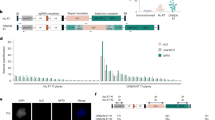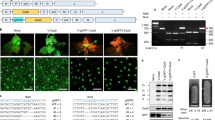Abstract
Agrobacterium tumefaciens is a pathogenic bacterium, which transforms plants by transferring a discrete segment of its DNA, the T-DNA, to plant cells. The T-DNA then integrates into the plant genome. T-DNA biotechnology is widely exploited in the genetic engineering of model plants and crops. However, the molecular mechanism underlying T-DNA integration remains unknown1. Here we demonstrate that in Arabidopsis thaliana T-DNA integration critically depends on polymerase theta (Pol θ). We find that TEBICHI/POLQ mutant plants (which have mutated Pol θ), although susceptible to Agrobacterium infection, are resistant to T-DNA integration. Characterization of >10,000 T-DNA–plant genome junctions reveals a distinct signature of Pol θ action and also indicates that 3′ end capture at genomic breaks is the prevalent mechanism of T-DNA integration. The primer–template switching ability of Pol θ can explain the molecular patchwork known as filler DNA that is frequently observed at sites of integration. T-DNA integration signatures in other plant species closely resemble those of Arabidopsis, suggesting that Pol-θ-mediated integration is evolutionarily conserved. Thus, Pol θ provides the mechanism for T-DNA random integration into the plant genome, demonstrating a potential to disrupt random integration so as to improve the quality and biosafety of plant transgenesis.
This is a preview of subscription content, access via your institution
Access options
Subscribe to this journal
Receive 12 digital issues and online access to articles
$119.00 per year
only $9.92 per issue
Buy this article
- Purchase on Springer Link
- Instant access to full article PDF
Prices may be subject to local taxes which are calculated during checkout



Similar content being viewed by others
References
Gelvin, S. B. Plant proteins involved in Agrobacterium-mediated genetic transformation. Annu. Rev. Phytopathol. 48, 45–68 (2010).
Salomon, S. & Puchta, H. Capture of genomic and T-DNA sequences during double-strand break repair in somatic plant cells. EMBO J. 17, 6086–6095 (1998).
Gallego, M. E., Bleuyard, J.-Y., Daoudal-Cotterell, S., Jallut, N. & White, C. I. Ku80 plays a role in non-homologous recombination but is not required for T-DNA integration in Arabidopsis. Plant J. 35, 557–565 (2003).
Friesner, J. & Britt, A. B. Ku80- and DNA ligase IV-deficient plants are sensitive to ionizing radiation and defective in T-DNA integration. Plant J. 34, 427–440 (2003).
Van Attikum, H. et al. The Arabidopsis AtLIG4 gene is required for the repair of DNA damage, but not for the integration of Agrobacterium T-DNA. Nucleic Acids Res. 31, 4247–4255 (2003).
Mestiri, I., Norre, F., Gallego, M. E. & White, C. I. Multiple host-cell recombination pathways act in Agrobacterium mediated transformation of plant cells. Plant J. 77, 511–520 (2014).
Park, S.-Y. et al. Agrobacterium T-DNA integration into the plant genome can occur without the activity of key non-homologous end-joining proteins. Plant J. 81, 934–946 (2015).
Windels, P., De Buck, S., Van Bockstaele, E., De Loose, M. & Depicker, A. T-DNA integration in Arabidopsis chromosomes. Presence and origin of filler DNA sequences. Plant Physiol. 133, 2061–2068 (2003).
Kleinboelting, N. et al. The structural features of thousands of T-DNA insertion sites are consistent with a double-strand break repair based insertion mechanism. Mol. Plant 8, 1651–1664 (2015).
Chan, S. H., Yu, A. M. & McVey, M. Dual roles for DNA polymerase theta in alternative end-joining repair of double-strand breaks in Drosophila. PLoS Genet. 6, e1001005 (2010).
Roerink, S. F., van Schendel, R. & Tijsterman, M. Polymerase theta-mediated end joining of replication-associated DNA breaks in C. elegans. Genome Res. 24, 954–962 (2014).
Koole, W. et al. A Polymerase Theta-dependent repair pathway suppresses extensive genomic instability at endogenous G4 DNA sites. Nat. Commun. 5, 3216 (2014).
Mateos-Gomez, P. A. et al. Mammalian polymerase θ promotes alternative NHEJ and suppresses recombination. Nature 518, 254–257 (2015).
Yousefzadeh, M. J. et al. Mechanism of suppression of chromosomal instability by DNA polymerase POLQ. PLoS Genet. 10, e1004654 (2014).
Inagaki, S. et al. Arabidopsis TEBICHI, with helicase and DNA polymerase domains, is required for regulated cell division and differentiation in meristems. Plant Cell 18, 879–892 (2006).
Desfeux, C., Clough, S. J. & Bent, A. F. Female reproductive tissues are the primary target of Agrobacterium-mediated transformation by the Arabidopsis floral-dip method. Plant Physiol. 123, 895–904 (2000).
Huang, S., An, Y. Q., McDowell, J. M., McKinney, E. C. & Meagher, R. B. The Arabidopsis ACT11 actin gene is strongly expressed in tissues of the emerging inflorescence, pollen, and developing ovules. Plant Mol. Biol. 33, 125–139 (1997).
De Buck, S., Podevin, N., Nolf, J., Jacobs, A. & Depicker, A. The T-DNA integration pattern in Arabidopsis transformants is highly determined by the transformed target cell. Plant J. 60, 134–145 (2009).
Kent, T., Chandramouly, G., McDevitt, S. M., Ozdemir, A. Y. & Pomerantz, R. T. Mechanism of microhomology-mediated end-joining promoted by human DNA polymerase θ. Nat. Struct. Mol. Biol. 22, 230–237 (2015).
Köhler, F., Cardon, G., Pöhlman, M., Gill, R. & Schieder, O. Enhancement of transformation rates in higher plants by low-dose irradiation: are DNA repair systems involved in the incorporation of exogenous DNA into the plant genome? Plant Mol. Biol. 12, 189–199 (1989).
Manova, V. & Gruszka, D. DNA damage and repair in plants – from models to crops. Front. Plant Sci. 6, 885 (2015).
Gallego, M. E. & White, C. I. DNA repair and recombination functions in Arabidopsis telomere maintenance. Chromosome Res. 13, 481–491 (2005).
Tzfira, T., Frankman, L. R., Vaidya, M. & Citovsky, V. Site-specific integration of Agrobacterium tumefaciens T-DNA via double-stranded intermediates. Plant Physiol. 133, 1011–1023 (2003).
Chilton, M. D. & Que, Q. Targeted integration of T-DNA into the tobacco genome at double-stranded breaks: new insights on the mechanism of T-DNA integration. Plant Physiol. 133, 956–965 (2003).
Durrenberger, F., Crameri, A., Hohn, B. & Koukolikova-Nicola, Z. Covalently bound VirD2 protein of Agrobacterium tumefaciens protects the T-DNA from exonucleolytic degradation. Proc. Natl Acad. Sci. USA. 86, 9154–9158 (1989).
Zhu, Q.-H., Ramm, K., Eamens, A. L., Dennis, E. S. & Upadhyaya, N. M. Transgene structures suggest that multiple mechanisms are involved in T-DNA integration in plants. Plant Sci. 171, 308–322 (2006).
Thomas, C. M. & Jones, J. D. Molecular analysis of Agrobacterium T-DNA integration in tomato reveals a role for left border sequence homology in most integration events. Mol. Genet. Genomics 278, 411–420 (2007).
Oosumi, T., Ruiz-Rojas, J. J., Veilleux, R. E., Dickerman, A. & Shulaev, V. Implementing reverse genetics in Rosaceae: analysis of T-DNA flanking sequences of insertional mutant lines in the diploid strawberry, Fragaria vesca. Physiol. Plant. 140, 1–9 (2010).
Singer, K., Shiboleth, Y. M., Li, J. & Tzfira, T. Formation of complex extrachromosomal T-DNA structures in Agrobacterium tumefaciens-infected plants. Plant Physiol. 160, 511–522 (2012).
Alonso, J. M. et al. Genome-wide insertional mutagenesis of Arabidopsis thaliana. Science 301, 653–657 (2003).
Beijersbergen, A., Dulk-Ras, A. D., Schilperoort, R. A. & Hooykaas, P. J. Conjugative transfer by the virulence system of Agrobacterium tumefaciens. Science 256, 1324–1327 (1992).
Lazo, G. R., Stein, P. A. & Ludwig, R. A. A DNA transformation-competent Arabidopsis genomic library in Agrobacterium. Biotechnol. (NY) 9, 963–967 (1991).
De Pater, S., Pinas, J. E., Hooykaas, P. J. J. & van der Zaal, B. J. ZFN-mediated gene targeting of the Arabidopsis protoporphyrinogen oxidase gene through Agrobacterium-mediated floral dip transformation. Plant Biotechnol. J. 11, 510–515 (2013).
Clough, S. J. & Bent, A. F. Floral dip: a simplified method for Agrobacterium-mediated transformation of Arabidopsis thaliana. Plant J. 16, 735–743 (1998).
Vergunst, A. C. et al. Virb/D4-dependent protein translocation from Agrobacterium into plant cells. Science 290, 979–982 (2000).
De Pater, S., Neuteboom, L. W., Pinas, J. E., Hooykaas, P. J. & van der Zaal, B. J. ZFN-induced mutagenesis and gene-targeting in Arabidopsis through Agrobacterium-mediated floral dip transformation. Plant Biotechnol. J. 7, 821–835 (2009).
Liu, Y. G., Mitsukawa, N., Oosumi, T. & Whittier, R. F. Efficient isolation and mapping of Arabidopsis thaliana T-DNA insert junctions by thermal asymmetric interlaced PCR. Plant J. 8, 457–463 (1995).
Acknowledgements
We thank B. Klemann and A. den Dulk-Ras for technical assistance and P. Lindenburg for photography. M.T is supported by grants from the European Research Council (203379, DSBrepair), the European Commission (DDResponse) and ZonMW/NGI-horizon. This work was also sponsored by the Royal Academy of Sciences (Academy Professorship award to P.J.J.H.).
Author information
Authors and Affiliations
Contributions
M.v.K. and M.T. conceived the study and designed the research with critical input from S.d.P. and P.J.J.H., who also provided infrastructure. M.v.K., S.d.P. and R.R. performed the experiments. R.v.S. performed bioinformatic analyses. All authors contributed to the interpretation of the results and to the manuscript, which was written by M.v.K. and M.T.
Corresponding author
Ethics declarations
Competing interests
The authors declare no competing financial interests.
Supplementary information
Supplementary Information
Supplementary Figures 1–12 (PDF 1731 kb)
Rights and permissions
About this article
Cite this article
van Kregten, M., de Pater, S., Romeijn, R. et al. T-DNA integration in plants results from polymerase-θ-mediated DNA repair. Nature Plants 2, 16164 (2016). https://doi.org/10.1038/nplants.2016.164
Received:
Accepted:
Published:
DOI: https://doi.org/10.1038/nplants.2016.164
This article is cited by
-
Intragenic Agrobacterium-mediated gene transfer mimics micro-translocations without foreign DNA
Planta (2024)
-
Effect of a suitable treatment period on the genetic transformation efficiency of the plant leaf disc method
Plant Methods (2023)
-
Regulation of gene editing using T-DNA concatenation
Nature Plants (2023)
-
CRISPR-Cas12a induced DNA double-strand breaks are repaired by multiple pathways with different mutation profiles in Magnaporthe oryzae
Nature Communications (2022)
-
Making it stick
Nature Plants (2022)



